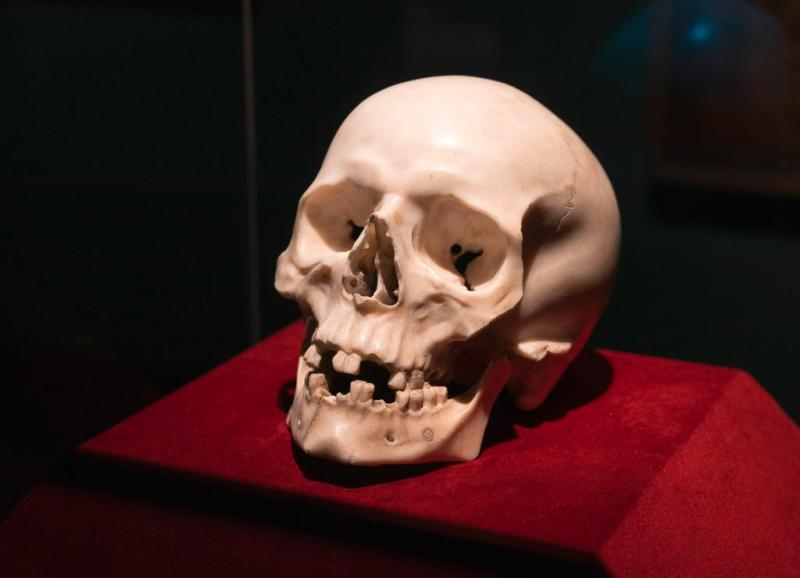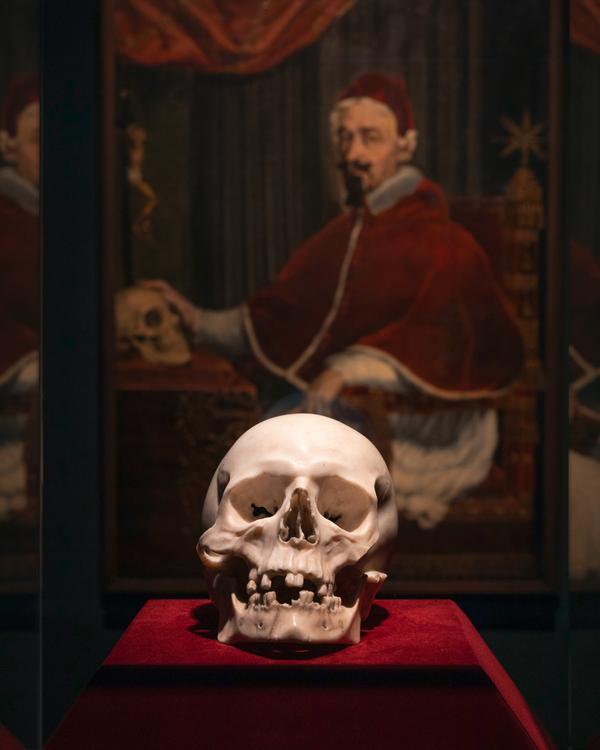Claudia Kryza-Gersch, curator of Renaissance and Baroque sculpture and member of one of TEFAF’s vetting committees, joined Dresden’s Skulpturensammlung (Sculpture Collection) in 2017, setting out to catalogue the bronzes of this important…
How This Masterful Marble Skull Became Attributed to the Great Baroque Artist Bernini
 Installation view of the exhibition Bernini, the Pope and Death at the Semperbau am Zwinger, Dresden. Photo: Oliver Killig. - Mit freundlicher Genehmigung von: tefaf
Installation view of the exhibition Bernini, the Pope and Death at the Semperbau am Zwinger, Dresden. Photo: Oliver Killig. - Mit freundlicher Genehmigung von: tefafWas: Ausstellung
Wann: 30.10.2014 - 28.10.2021
Wo: Dresden, Deutschland
Claudia Kryza-Gersch, curator of Renaissance and Baroque sculpture and member of one of TEFAF’s vetting committees, joined Dresden’s Skulpturensammlung (Sculpture Collection) in 2017, setting out to catalogue the bronzes of this important collection. “Little did I know that the Skulpturensammlung is full of unnoticed treasures, and so far, I stumbled from one discovery to the next, without having time to work on that catalogue,” Kryza-Gersch shares. One of these unnoticed treasures is Death’s Head, a remarkably realistic, life-sized marble skull, worked fully in the round, including the underside. It had been on loan to the Kunstgewerbemuseum (Museum of Decorative Arts) in castle Pillnitz since 2006 and was described as “Italian, around 1700.” The first time the curator saw the skull in person was in the conservation lab when it was being considered for an upcoming exhibition, an experience that left her feeling awestruck by the skull’s quality. “We were all convinced that this must be the work of a great artist, and since we knew from our documentation that it was bought in Rome in 1728, one of us jokingly suggested that it might be by Bernini.” The marble skull indeed turned out to be a work once thought lost by the sculptor and architect Gian Lorenzo Bernini (1598-1680).
Bernini’s Death’s Head is now on display in the exhibition Bernini, the Pope and Death (through 21 November, 2021), which explores the themes of the preciousness of life and the power of art, and presents the skull together with other works showcasing the artist’s creations under the pontificate of Pope Alexander VII. Here, Kryza-Gersch shares the details of her work and research to uncover the story of the skull and identifying its maker.
Establishing a picture-perfect provenanceArchival research played an essential part in discovering the skull’s story—in particular, its provenance, for which the museum’s documentation provided a starting point. It was recorded that the skull was part of an acquisition of 160 pieces of antique sculpture and four 17th-century works by the great art patron Augustus the Strong, Elector of Saxony and King of Poland (1670-1733). These works had been brought together by Cardinal Flavio Chigi (1631-1693) in the second half of the 17th century and were purchased en bloc from his heirs in 1728. Kryza-Gersch came across a letter written by Raymond le Plat, the art agent of Augustus, describing that the purchase of the Chigi collection would include also “Un tête du mort du Bernini,” but the artist’s name was seemingly forgotten in Dresden over time. “As the Chigi collection is mainly one of antiquities, it had so far been studied only by archeologists, which is why the mentioning of a skull by Bernini did not arouse great interest,” Kryza-Gersch explains. She pursued the skull’s history in the inventories of the Chigi family, which can be consulted – “luckily, for we were in the midst of the second lock down” – on the website of the Vatican Apostolic Archive. “In these records, it was possible to follow the skull all the way back to the inventory of Cardinal Flavio Chigi’s art collection, compiled in 1692, where one can find the entry: “Una testa di morto di marmo di Carrara fatta del Bernini.”
Kryza-Gersch then approached the object from the perspective of Bernini’s oeuvre. It had been known that Bernini was commissioned a skull of marble for Pope Alexander VII (1599-1667) as a poignant reminder of the inevitability of death, which lured close around the corner in the 17th century. The then newly-elected pope was born Fabio Chigi and was none other than the uncle of Cardinal Flavio Chigi. “It was then fairly easy to put all the pieces of the puzzle together: Bernini made the skull in 1655 for Alexander VII, and Flavio Chigi inherited it after the pope’s death. It remained in the family’s possession until it was sold to Dresden: a picture-perfect provenance.”
While documentation plays an important role in art historical research, Kryza-Gersch shares that it can also be confusing, and documents should be read carefully. “During my research, I came across a reference according to which the sculptor Baldassare Mari was paid for a skull made for the pope. Since Mari was one of the many assistants working in Bernini’s workshop, I had to ask whether the Dresden Death’s Head was perhaps not by Bernini but by one of his collaborators.” Luckily, Mari’s work can be found in Dresden since he restored many of the antique sculptures in Flavio Chigi’s collection, which provided an opportunity for Kryza-Gersch to study the artist’s qualities. “Restoring in the 17th century meant adding heads, torsos, limbs—basically whichever elements were missing from a sculpture. When I looked at these additions, it became clear that Mari was a good artisan, but not more. It seemed to me inconceivable that he should be the creator of the brilliant Death’s Head.” As it turned out, Mari did make a second skull for Alexander VII, who gifted it to his nephew Flavio. “The one by Bernini, he kept for himself, of course.”
The importance of the bigger picture: Bernini’s life and careerWhile the skull’s provenance provided a clear path to attribution, gaining an understanding of the artist’s life and career was equally important. “It’s not all in the documents; one always has to look at the entire picture,” says Kryza-Gersch. Under the pontificate of Pope Urban VIII, Bernini rose to the ranks to become the preeminent artist in Rome. However, when Urban VIII died, he was succeeded by Innocent X, and Bernini fell from grace due to personal animosities and his failed bell towers for Saint Peter’s Cathedral. The election of a new pope introduced an opportunity for Bernini to turn the page. “Only three days after Fabio became Alexander VII, Bernini was commissioned to create a skull, which the pope wanted to keep on his desk as a permanent memento mori. Visible evidence of this is provided by a portrait of Alexander VII by Bernini’s pupil Guido Ubaldi Abbatini, who died in 1656 of the plague—a strong reminder of just how quickly life could be over in the 17th century. This painting can be seen in the exhibition as a loan from the Collection of the Sovereign Military Order of Malta, Rome.” The skull may seem a small and almost humble commission, but it was certainly a very important one for Bernini, because it had the potential to stand at the beginning of a hopefully fruitful relationship with the new pope. And indeed, Bernini and Alexander VII, who were almost of the same age, became friends and together transformed Rome into the city we know today. “If one considers the commission of the skull from the point of view of Bernini’s career, it seems clear that it was far too significant to be left to an assistant,” says Kryza-Gersch.
Insight into Bernini’s religious beliefs and routines also provided a broader understanding of the context in which the artist lived and worked, and the importance of this commission from a personal perspective. “One knows how deeply religious Bernini was and that he reflected a lot about death. Since the 1640s, every Friday he attended what were known as the “devotions of the good death” in the Jesuit church of il Gesù. Like Alexander VII, Bernini considered death as a way to heaven for which one had to prepare. Someone with such deep devotion who receives this commission from the newly-elected pope does not leave the execution to someone else,” says Kryza-Gersch. “In my view, there can be no doubt that the Death’s Head in Dresden is the very same one that Bernini executed personally for Alexander VII in 1655.”
“Death’s Head is actually the ‘portrait of a skull,’ and that makes it such a deeply moving work of art.” — Claudia Kryza-Gersch A realistically rendered “portrait of a skull”
For Kryza-Gersch, one of the Death’s Head elements that most demonstrates Bernini’s artistic personality—and one of its most striking features—is its realism. Introducing other fields of research, she shares that it was confirmed by a forensic anthropologist that, anatomically, the skull is rendered almost perfectly. “The only liberty that Bernini took was to enlarge the hole on the underside, likely to have better access hollowing it out. This degree of observation, subtlety, and virtuosity with which every detail is rendered connects the Death’s Head with Bernini’s brilliant portrait busts. He devoted the same care he gave a portrait of a living man to the rendering of the skull—Death’s Head is actually the ‘portrait of a skull,’ and that makes it such a deeply moving work of art.”
This interview has been edited and condensed.
Von Cheyenne Wehren 22. Oktober 2021
.
 Gian Lorenzo Bernini, Death’s Head. Staatliche Kunstsammlungen Dresden, Skulpturensammlung. Photo: Oliver Killig. - Mit freundlicher Genehmigung von: tefaf / The European Fine Art Foundation
Gian Lorenzo Bernini, Death’s Head. Staatliche Kunstsammlungen Dresden, Skulpturensammlung. Photo: Oliver Killig. - Mit freundlicher Genehmigung von: tefaf / The European Fine Art Foundation Installation view of Guido Ubaldo Abbatini’s Pope Alexander VII with Bernini’s Death’s Head, 1655/56, and Gian Lorenzo Bernini’s Death’s Head. Collection of the Sovereign Order of Malta and Staatliche Kunstsammlungen Dresden, Skulpturensammlung. Photo: Oliver Killig. - Mit freundlicher Genehmigung von: tefaf / The European Fine Art Foundation
Installation view of Guido Ubaldo Abbatini’s Pope Alexander VII with Bernini’s Death’s Head, 1655/56, and Gian Lorenzo Bernini’s Death’s Head. Collection of the Sovereign Order of Malta and Staatliche Kunstsammlungen Dresden, Skulpturensammlung. Photo: Oliver Killig. - Mit freundlicher Genehmigung von: tefaf / The European Fine Art Foundation View of the underside of Gian Lorenzo Bern - Mit freundlicher Genehmigung von: tefaf / The European Fine Art Foundation
View of the underside of Gian Lorenzo Bern - Mit freundlicher Genehmigung von: tefaf / The European Fine Art FoundationCopyright © 2025 findART.cc - All rights reserved

